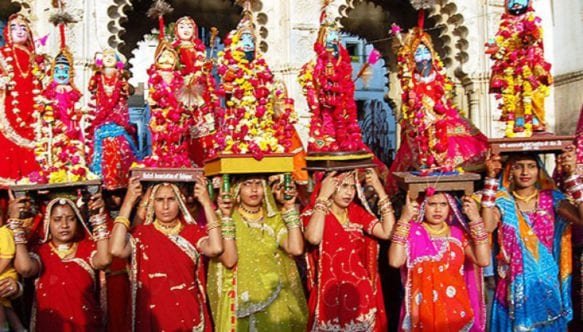
Gangaur Festival in Jaipur
About Gangaur Festival in Jaipur
Gangaur is one of the foremost biggest colorful festivals rejoiced with great enthusiasm and happiness everywhere in the Indian state of Jaipur Rajasthan. within the word Gangaur, ‘Gan’ is that the synonym for Lord Shiva whereas ‘Gaur’ stands for Gauri or Goddess Parvati. But mainly, this festival is held within the respect of Goddess Parvati as she is considered the epitome of marital love, courage, power, strength, and excellence.
During the festival, married women worship of Goddess Parvati for the long life, well being and wealth of their husbands while the women pray for getting a sensible and understanding life partner. The festival is rejoiced within the month of Chaitra, the primary month of the Hindu calendar and falls between March and April, consistent with the Gregorian calendar. It begins on the very first day Chaitra month, the day after Holi and is widely known for 18 days. Also, it marks the top of the winter season and therefore the coming of the spring season.
Women and girls observe fast during this festive time and eat just one occasion during a day. Images of Gauri and Isar (Lord Shiva) are made with the clay and decorated very beautifully. On the opposite hand, in a number of the Rajput families, images are made from wood per annum before the festival they’re painted by the famous painters who are called ‘Matheran’s’. The pictures which are made during this point don’t have canopies.
Women and girls, during the festival, wear new dresses, adorn themselves with jewelry and make designs on their palms and feet by applying Mehandi (henna). On the 7th-day evening, girls carry ‘gladiolas’, which are earthen pots with many holes inside which a lamp is lit, on their heads. They sing songs of Gangaur and are given gifts within the sort of money, ghee, sweets, jaggery, etc. by the elders of the family as a token of affection.
This ritual goes on for 10 days and on the Judgment Day women and girls break the pots and throw the broken pieces into a well or a tank; the clay idols made by the married women also are immersed in water on the Judgment Day of the festival. A grand procession is held which starts from the Zanani-Deodhi of the town Palace which then goes through Tripolia Bazaar, Gangauri Bazaar, Chaugan Stadium, Chhoti Chaupar, and eventually converges near the Talkatora. This procession is headed by a colorful show of elephants in this festival, chariots, bullock carts, old palanquins, and performance folk artistes. People regardless of their caste and creed come to watch and to be a neighborhood of the procession.
Rituals Performed during Gangaur Festival in Jaipur
The festival starts on the primary day of Chaitra, the day next to the Holi festival. From the day of the Gangaur festival, the ladies fast for 18 days to finish the ritual. During this 18-day period, women or Girls eat just one occasion per day. The Gangaur festival ends on the third day of Shukla Paksha.
How Gangaur Festival in Jaipur is Celebrated in Jaipur?
Throughout the 18 days, the town celebrates with an active fair that sells all types of souvenirs, masterpieces, and interesting activities. The small statue of the God and Goddess is made out of clay for the rituals. Some of the families use their traditional wooden images, which they paint on the eve of the Gangaur festival. This image or idol is employed for rituals for the whole course of the fasting. Women decorate their hands and feet by applying myrtle paste in shapes of figures like the flower, geometric design, and others.
On the seventh day from Holi, unmarried women carry small earthen lamps and walk round the streets, singing ghudlia songs. This continues for the subsequent ten days. On the 18th day, the Gangaur festival day, the earthen pot is destroyed and therefore the remains are thrown into a tank or well. Later, the ladies break their fast by enjoying a feast.
The last three days are the simplest part of the festival. The locals decorate their deities with ornaments and dresses. At an auspicious time, the locals form a procession with the deities on the top of married women. The deities are placed during a garden, pond or near a well. For the subsequent two days, the procession returns to supply prayers and rituals. On the ultimate day, the idols are thrown into the water, bidding farewell to Gauri. It indicates the celebration of sending Goddess Gauri to her consort’s house.
